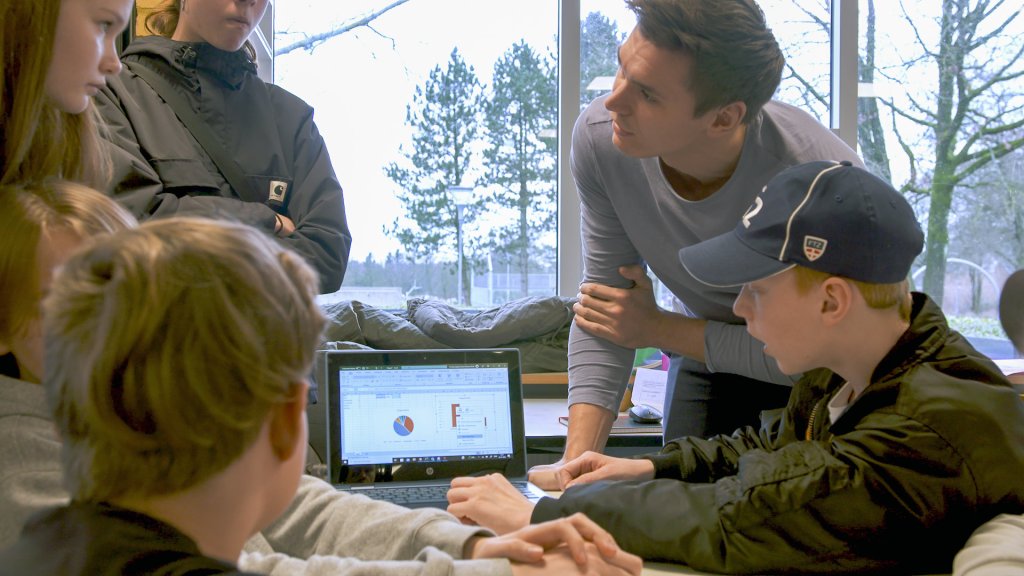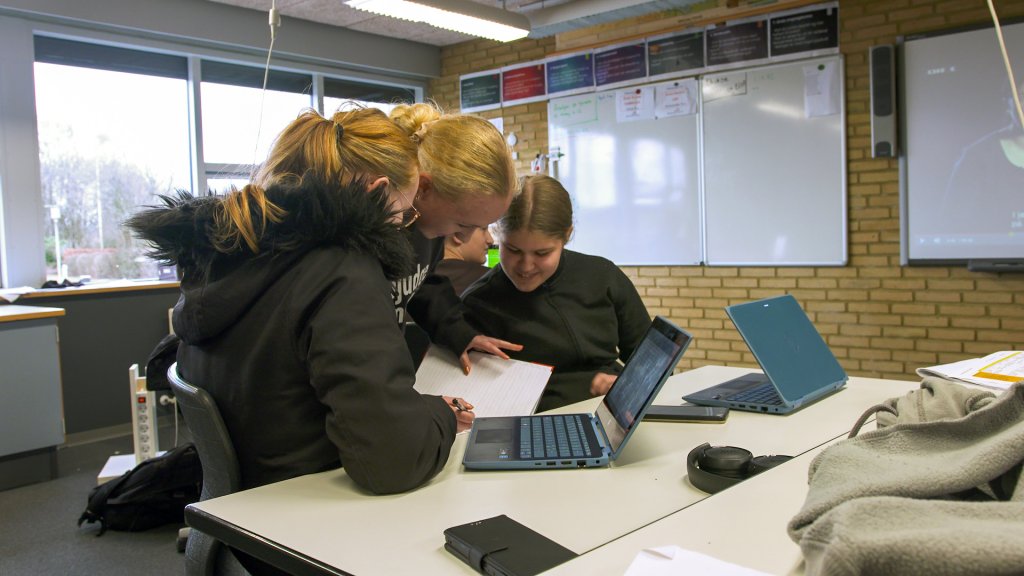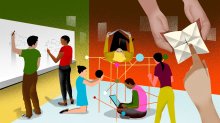Across Grade Levels, Should Learning Be a Lot More Playful?
Denmark has fully embraced playful learning in its K–12 schools. We visited two schools to see the pedagogical approach in action.
Your content has been saved!
Go to My Saved Content.As the sun peeks over the horizon in Vorbasse, Denmark—well before the first bell—seventh-grade teacher Nicolaj Bech is reviewing his class opener and the day’s learning objectives with Maria Astrup Bendixen.
Astrup Bendixen isn't your typical instructional coach. She's a playful learning coordinator, and her job is to work with teachers like Bech to make his lessons, and learning generally, more joyful and engaging for the kids he teaches.
The Vorbasse Skole, the K–9 public school where Bech works, and the rest of Denmark pivoted to playful learning four years ago, joining an international playful learning movement taking hold in countries from Scotland to South Africa and Colombia.
As with any innovative change to a longstanding system, adopting playful learning comes with its own set of challenges—something Bech and Astrup Bendixen contend with on the day we visit. “The students are typical year-seven students,” says Astrup Bendixen. “Some like the possibility of play and agency, deciding what they want to do and how they want to do it. But some of them don’t. Some just want to be told, ‘You have to do this assignment,’ and that’s it. So for some students, we know we need to plan something different.”
On the January day of our visit, Bech and Astrup Bendixen plan to kick off a holiday-focused project-based learning unit called Yours, Mine, and Our World—integrating standards from academic disciplines including math, English, and social studies—by playing a clip from a Thanksgiving episode of the sitcom Friends. Instead of learning about international traditions more passively via worksheets, lectures, and assigned reading, Bech wants students to be active, “move around and talk to each other,” following a core tenet of playful learning.
As part of the lesson, small groups of students will get up out of their seats to poll classmates in neighboring classrooms, asking them what they eat for Christmas dinner and gathering holiday-related statistical data. Afterward, they’ll collaborate to organize their data into charts—adding an important social component. Collecting the data themselves is also a crucial piece of the puzzle, Bech says, because it engages them in the activity and gives a sense of ownership.
“That’s something we work on a lot, having students find things out for themselves instead of teaching it traditionally,” he says. “I could put all the numbers up on the smartboard and say, ‘This many people in Denmark had potatoes, this many people had duck,’ but it doesn’t really give the same sense of ownership as ‘This is my chart. I made it from the data that I collected myself.’”
In spite of Bech and Astrup Bendixen’s careful planning, however, the lesson doesn’t unfold as smoothly as they’d hoped—but that’s all part of the process, they later acknowledge, as playful learning involves a great deal of trial and error. Making the lessons fit who the students are takes time and effort, and success may be heavily impacted by the mindset that kids show up with that day.

As students file into the classroom that morning, their energy seems low, and many appear tired—not unusual for 12- and 13-year-old kids. Without Danish subtitles, many students don’t fully understand the Friends clip. They do get into groups and start collecting data, but a group or two mistakenly go into the wrong classroom, and the confusion momentarily derails them. Some groups seem unclear about next steps upon returning to the classroom; others get to work quicker and complete their charts. A few “pull back,” Astrup Bendixen says later, allowing “one member to do all of the group’s work” while they watch.
A Sweet Spot for Learning
At first glance, Bech’s classroom appears noisy and somewhat chaotic—not the ideal conditions, at least on the surface, for effective learning—yet that’s the unconventional and sometimes uncomfortable nature of playful learning. More traditional approaches often foreground teacher-led direct instruction but can unintentionally produce lockstep compliance rather than tapping into intrinsic motivation. A more playful approach, meanwhile, aims to create an environment that supports the often vibrant, dynamic, and free-flowing nature of student-led learning and discovery.
Playful learning is structured around curricular standards—it remains at its core focused on academic learning—but it is powered by each student’s own inquiry. Educators plan ways to meaningfully connect learning goals to students’ lives, while creating opportunities for peers to interact and explore new concepts together in unconventional ways. The goal is a classroom environment where students eventually become invested in learning and comfortable experimenting and taking risks.
At its best, playful learning is the sweet spot “when the learning goals of adults and the interests and curiosities of students align,” says Ben Mardell, early childhood educator and lead author of the newly released Pedagogy of Play: Supporting Playful Learning in Classrooms and Schools. “Some people might hear that and say, ‘Well, how can you do that?’ But actually, human beings like to learn,” says Mardell. “Probe any teenager, and they may not be super-keen on school, but they’re interested in something. Finding their entry points and their interests to make learning meaningful is the job of a teacher, melding our learning goals into that.”
A number of paradoxes exist between school and play as we know it, which makes the whole idea of infusing playful learning into classrooms a complex pursuit: Allowing students to develop agency and lead their own learning, for example, can quickly unravel without the right structural supports, says Mara Krechevsky, a senior researcher working with Mardell at Project Zero, a Harvard-based educational research center.
While in school, kids are supposed to approach things safely, she explains, yet play is all about taking risks. School schedules and agendas are generally set by adults, but when children play, they’re in charge. Schools are places of structure and order, which is “very important for some kids to learn,” Krechevsky acknowledges, but play is often chaotic, messy, and loud. “Both of these things are important, right?” she says. “We’re not saying school shouldn’t be safe, so these paradoxes or tensions are always going to be there. The question is, how do you navigate them?”
Laughter and Rich Conversation
About three hours’ drive from Bech’s classroom, teacher Fatima Belouahi integrates playful learning into her ninth-grade English language learning classroom in the Danish capital city of Copenhagen. Belouahi has worked with this group of kids for four years across several subjects, developing deep relationships and setting clear expectations over time, which allows the class we’re invited to observe to progress a bit more smoothly than Bech’s.
The day’s schedule is posted on the board for all students to see: Some parts of the lesson are playful, inviting students to stand and discuss meaningful topics or illustrate vocabulary terms that their partner will try to guess. Other parts are more traditional, like reading and discussing texts in small groups or practicing writing short answers to questions in English.
Belouahi’s students, older than Bech’s and already accustomed to the flow of playful learning given Belouahi’s extensive training in the philosophy, seem attuned to the rhythms of her classroom and schedule. As soon as she delivers instructions, they quickly get to work, and Belouahi walks around the room, observing and answering questions as needed.
That day, the classroom is often filled with the sounds of laughter and rich conversation. At one point—as the class enters the school’s makerspace to work on projects in small groups—a student tells this reporter that she loves the class because it “makes her feel like a kid again.”
Under Belouahi’s supervision, students seamlessly move from more conventional tasks—like summarizing short articles or translating English vocabulary terms into Danish—to more playful ones, like role-playing various scenarios to practice using English in real-world situations.
The all-too-familiar moans and groans as kids approach an activity or task they’re not excited about are noticeably absent. Rather, we see an educational ecosystem ticking along as students seem to grasp the value that each assignment adds to their learning experience, approaching each new component with an open mind.
An important baseline that Belouahi establishes with students early in the school year relates to the role each student plays in the learning process. “I typically talk to them about not just what we are responsible for as teachers, but what the student’s responsibilities are for a lesson to be successful,” says Belouahi. “Their responsibility is that they engage in the subject matter, even if it’s not something that interests them.” As time passes, she says, students begin to understand that “the lesson will get better if they’re actively participating, and it will be more fun.”
It’s About Many Teachers
The Vorbasse Skole where we observed Bech’s seventh-grade class has a long tradition of trying out new ways of teaching, says vice principal Merete Vester. In 2019, the Lego Foundation and the Billund Municipality, where the town of Vorbasse is located, began a collaboration to encourage all schools to explore playful project-based learning. The Vorbasse Skole became the pilot school, implementing playful learning in the seventh, eighth, and ninth grades before the approach trickled down to the middle grades. Today, the school considers itself deeply rooted in playful learning—from kindergarten to ninth grade.
In order not to overload teachers, schoolwide playful learning should involve a collaborative effort, Mardell says. It’s not a singular, amazing teacher doing transformative work all by themselves, but “many teachers being supported by both their colleagues, by the school leaders, and having other resources to do this work.”
At the Vorbasse Skole, there are many levels of support. The municipality first provided two school-based consultants to help implement playful learning and support teachers. Weekly meetings became a regular occurrence where staff attended workshops and received tools to aid their own learning process—a practice they continue to this day. Every team in each department meets on Wednesday to discuss new methods or work in small teams to plan lessons or projects. Additionally, each department has a playful learning coordinator to help support colleagues, and staff attend regular professional development sessions to bolster their playful learning skills.
‘What If There Was More Than One Way?’
Initially, educators at Vorbasse were worried about the impact of playful learning on students’ academic outcomes. “Our first thought was, ‘We can’t have ninth graders involved with this because they need to focus on the exam,’” says Vester, the school’s vice principal.

So far, students are tracking right along—in many cases, outpacing students who learned at the school prior to the adoption of playful learning. In their year-end exams, the students who “worked with project-based learning and playful learning last year did better than the students before,” says Astrup Bendixen, the playful learning coordinator. “They’ve become used to being engaged in what they are working with, and used to having another way of thinking about what they’re learning. There are so many benefits—though the benefits also have to be within the restrictions we have, such as curricula and exams.”
Meanwhile, Vester says that when visitors stop by to observe, they now see formerly shy ninth graders who can proudly explain how their newly developed time management skills help them study for exams. The exams themselves now feel a lot less stressful for students: “Watching them present at the exams—it’s amazing how they can deliver, and that was something they couldn’t do before,” Vester says, with an equal measure of amazement and pride.
While playful learning is still in its infancy at the Vorbasse Skole, Astrup Bendixen believes it’s bringing out the best in students. Informed by the tenets of playful learning, teachers are constantly finding ways to engage and motivate kids and make learning more meaningful. In return, students “give us more of who they are,” she says. “We know them in another way.”
The researchers at Project Zero speak about playful learning quite broadly as involving students through “leading their own learning, exploring the unknown, and finding joy.”
“If there’s only one way to do things, that often kills play,” says Mardell, the lead author of Pedagogy of Play. “But what if there was more than one way? There could be more than one way to get to the right answer or to share what I’ve learned, and even more than one way to sit in the classroom. I think that opens up a world of possibilities.”
Edutopia has been visiting schools around the world that make play central to their pedagogy, as part of our effort to uncover evidence-based strategies that any teacher can adopt to drive creativity, student agency, and better academic outcomes.
